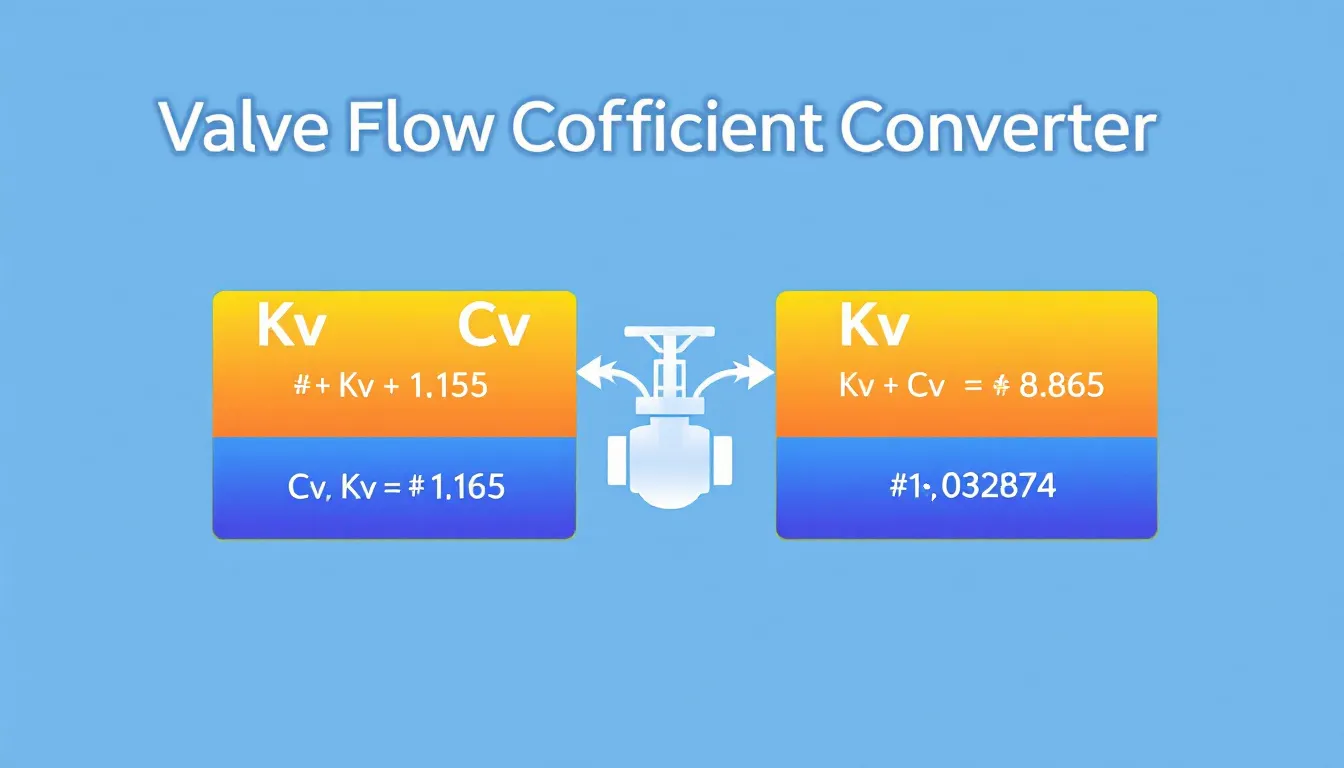Valve Flow Coefficient Converter
Is this tool helpful?
How to use the tool
- Select conversion type—“Kv ➜ Cv” or “Cv ➜ Kv”.
- Enter a value. Example 1: 50 Kv. Example 2: 200 Cv.
- Hit Convert to see the result.
- Read the answer; it appears below the form with two-decimal precision.
Formulas applied
The calculator uses the standard water-based coefficients:
$$Cv = Kv \times 1.156$$ $$Kv = Cv \times 0.865$$Example calculations
- Input 50 Kv ➜ $$50 \times 1.156 = 57.80$$ Cv.
- Input 200 Cv ➜ $$200 \times 0.865 = 173.00$$ Kv.
Why the factors matter
- The 1.156 factor aligns metric flow (m³/h) with imperial flow (gpm) under identical pressure drops (Crane TP-410, 2019).
- The inverse 0.865 factor ensures consistency when moving data back to metric units (ISA S75.01, 2020).
Quick-Facts
- Water density at 15 °C: 999 kg/m³ (NIST, 2023).
- 1 m³/h equals 4.403 gpm (ISO 31-3, 2019).
- Reference drop: 1 bar = 14.5038 psi (NIST, 2023).
- Conversion constant Cv/Kv = 1.156 (Crane TP-410, 2019).
- Industrial control valves span 0.1 Cv to 12 000 Cv (Emerson Fisher Catalog, 2022).
FAQ
What is Kv?
Kv is the water flow in m³/h through a valve with 1 bar drop at 15 °C (IEC 60534-2-1, 2011).
What is Cv?
Cv is the water flow in gpm through a valve with 1 psi drop at 60 °F (ISA S75.02, 2020).
How do I convert Kv to Cv quickly?
Multiply Kv by 1.156, then round as needed (Crane TP-410, 2019).
Why convert between Kv and Cv?
You convert to compare valves specified in different unit systems on global projects (API RP 553, 2021).
Can I use the same factor for gases?
No. Gas sizing needs density and compressibility corrections (ISO 5167, 2022).
Does temperature change the factor?
The 1.156 factor assumes standard water temperatures; large deviations require recalculation (IEC 60534-8-3, 2010).
What if my pressure drop differs from 1 bar or 1 psi?
First normalize flow to the reference drop using $$Q ˙ ∝ rac{1}{\sqrt{ΔP}}$$, then convert (ISA S75.01, 2020).
How accurate is the factor?
The error stays below 0.5 % for incompressible liquids, per “Control Valve Handbook” section 2.3 (Emerson, 2022).
Important Disclaimer
The calculations, results, and content provided by our tools are not guaranteed to be accurate, complete, or reliable. Users are responsible for verifying and interpreting the results. Our content and tools may contain errors, biases, or inconsistencies. Do not enter personal data, sensitive information, or personally identifiable information in our web forms or tools. Such data entry violates our terms of service and may result in unauthorized disclosure to third parties. We reserve the right to save inputs and outputs from our tools for the purposes of error debugging, bias identification, and performance improvement. External companies providing AI models used in our tools may also save and process data in accordance with their own policies. By using our tools, you consent to this data collection and processing. We reserve the right to limit the usage of our tools based on current usability factors.







